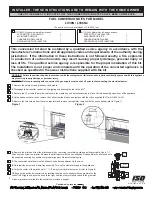
3 Installation
OxyMax W COS 71
10
Hauser
3.4.2 Functional description
Polarisation
When the sensor is connected to the transmitter, a fixed external voltage is applied
between the cathode and anode. The resulting polarisation current is indicated on a
display on the transmitter. The current starts high but then drops over time. The sensor
can only be calibrated when the display is stable.
Membrane
The oxygen dissolved in the medium is conveyed to the membrane by the incoming
flow. The membrane is only permeable for dissolved gases. Other substances
dissolved in the liquid phase e.g. ionic substances, will not penetrate through the
membrane. Therefore, medium conductivity has no impact on the measuring signal.
Only the white membrane cap with a 25 µm membrane (fast response time) is used for
the sensor COS 71. Do not use the black membrane cap with 50 µm membrane
(for sensor COS 31 resp. COS 41).
Amperometric measuring principle
The oxygen molecules diffused through the membrane are reduced to hydroxide ions
(OH
-
) at the gold cathode. Silver is oxidised to silver ions (Ag
+
) at the anode (this forms
a silver bromide layer, AgBr).
A current flows due to the connected electrode release at the gold cathode and
accepted at the anode. In equilibrium, this flow is proportional to the oxygen content of
the medium.
This current is converted in the measuring instrument and indicated on the display
as an oxygen concentration in mg/l, as a saturation index in % SAT or as an oxygen
partial pressure in hPa.
Potentiostatic three-electrode system
Unlike the two-electrode system the anode of the three-electrode system is splitted in a
current-carrying counter electrode and a currentless reference electrode. The latter
shows an essentially better potential stability due to its high resistance wiring. A closed
control loop inside the sensor electronics together with the three-electrode system
results in correct adjustment of the oxygen specific working potential at the gold
cathode. In case of advanced electrolyte consumption or in case of high measuring
current the loop tuning remains reliable. The advantages are an essentially better signal
accuracy and an extension of the calibration intervals.
Adaptive control of polarisation voltage (ACPV)
The potential of the working electrode versus the reference electrode is continuously
changed depending on the measured current value. The ACPV function calculates an
optimum polarisation voltage from the instantaneous sensor current and controls it. This
leads to an effective minimisation of the oxygen independent zero current. The
advantages are a better signal resolution and a linearity of the calibration function also
with very small oxygen concentrations.
Self control
Continuous resistance measurement between the measuring chamber and the medium
leads to immediate identification of leakages of the membrane or of the measuring
chamber locking. This provides a high protection from measuring errors, from escaping
of the electrolyte or from penetration of the medium into the electrolyte.
This function is not available in media with very low conductivity.
Summary of Contents for OxyMax W COS 71
Page 2: ......












































